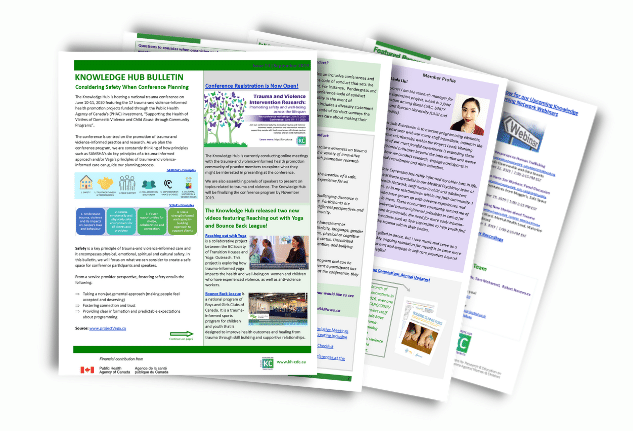Bulletin 14
Considering safety when conference planning
Safety is a key principle of trauma-and violence-informed care and it encompasses physical, emotional, spiritual and cultural safety. In this bulletin, we will focus on what we can consider to create a safe space for conference participants and speakers.
From a service provider perspective, fostering safety entails the following:
- Taking a non-judgemental approach (making people feel accepted and deserving)
- Fostering connection and trust
- Providing clear information and predictable expectations about programming
Source: www.projectVega.ca
Questions to consider when organizing conferences & events:
- Does the physical environment promote a sense of safety, calming, and de-escalation?
- Are we providing space where participants can go to practice self-care?
- Have we developed mechanisms to address gender-related physical and emotional safety concerns (e.g., gender-specific spaces and activities)?
- Strategies that the Knowledge Hub is working towards adapting:
- Develop and include a conference code of conduct in the conference program and registration webpage Maintain communication that is open, respectful, and compassionate.
- Allow ample time for potential conference participants to make the necessary arrangements to be able to attend.
- Incorporate a traditional Indigenous opening and closing.
- Identify Elders and support professionals in the conference program and where they can be reached during the event.
- Use welcoming language on all signage .
- Welcome conference participants and presenters and ensure that they feel respected and supported.
- Parking lots, common areas, washrooms, entrances, and exits are well lit.
- Gender neutral washrooms are clearly marked with proper signage.
- Provide microphones to meet accessibility standards
- Adhere to the conference program to meet attendees’ expectations.
- Provide opportunities for self-care activities, such as mindfulness, colouring and playdough activities.
- Offer preferred pronoun and “no photos” buttons.
Why a conference code of conduct?
Various guides, blogs and articles on inclusive conferences and events recommend developing a code of conduct that sets the ethical expectations of the event. For instance, Pendergrass and colleagues (2019)1 note that a conference code of conduct creates a structure of accountability in the event of inappropriate behaviour. It often includes a diversity statement and an anti-harassment policy. A code of conduct conveys the message that conference organizers care about making their attendees feel safe.
Resources to consider
Guide to planning inclusive meetings Guide to Planning Inclusive Meetings - Canada.ca
Diversity through inclusive practice: An evolving toolkit for creating inclusive processes, spaces & events Diversity through Inclusive Practice: An Evolving Toolkit for Creating Inclusive Processes, Spaces & Events (dawncanada.net)

